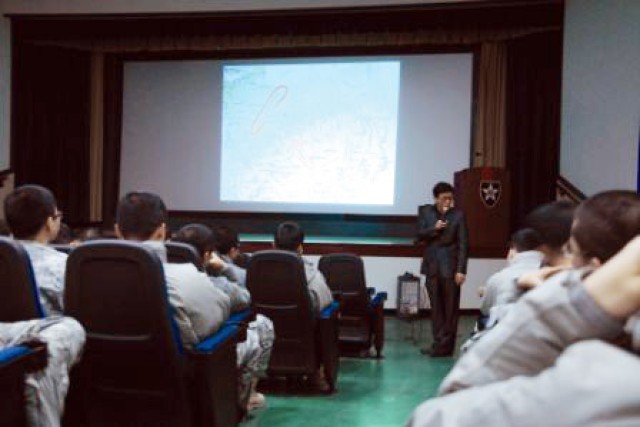
RED CLOUD GARRISON - Korean Augmentation to the United States Army soldiers gathered in USAG-Red Cloud's theater Jan. 14 to hear a special lecture from Dr. Park, Jong Duck of the National Institute for Korean Language.
Park came at the invitation of the Republic of Korea army as part of their weekly meetings where KATUSAs are given briefings on the status of issues with North Korea and other subjects dealing with political situations between the two Korea's. Subjects briefed in such meetings can range between national pride to better knowing their enemy. This briefing dealt with the origins of the Korean language.
"Koreans have been mistakenly taught their language originated in middle Asia," Park said. "After many years of research and study, we know this notion is wrong."
Park continued to explain how the Korean language came about within the boundaries of modern day Korea. Early historical records point out two groups of languages were spoken in Manchuria and the Korean peninsula before the 7th century. During the middle of the 7th century, the kingdom of Shilla unified the peninsula and its language became dominant. During the 10th century, the Koryo Dynasty was founded and the capital was relocated to Kaesong in the center of the peninsula. From that time on, the dialect of Kaesong became the standard national language.
The script, generally called Han-gul, is basically an invented language, invented by the fourth king of the Choson Dynasty, Sejong (1418-1450). It was then called Hunmin Chong-um, which means "proper sounds to instruct the people." The script, however, did not appear until 1446 when Hunmin Chong-um appeared in a written document. The reason for the invention of the Korean script, according to King Sejong, was to enable the Korean people to write their own language without the use of Chinese characters. A second motivation for the script was to represent the proper sound associated with each character.
When King Sejong and his scholars attempted to invent a Korean writing system, scholars believe he probably looked to several writing systems already known, such as Chinese old seal characters, the Uighur script, and the Mongolian scripts. The system, for which he settled however, is predominantly based on phonology, or how syllables and words are pronounced, Park explained.
"This system made the Korean alphabet one of the easiest and most scientific in the world," Park said.
Pvt. Kim, Hyun Soo, Headquarters, Headquarters Company, USAG-RC, came away from the meeting impressed with the new information.
"I was very impressed with the briefing today," Kim said. "It was not only insightful, but it gave me a sense of national pride as well."

Social Sharing